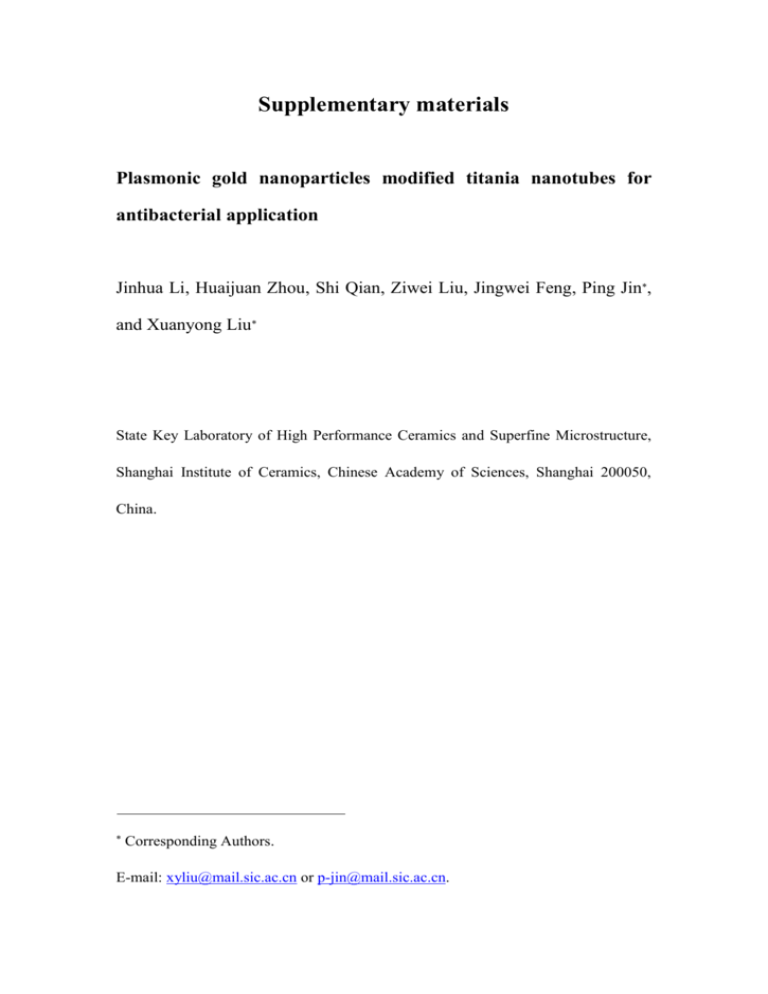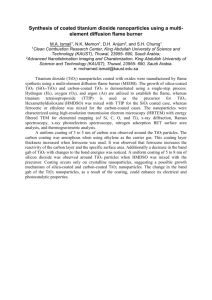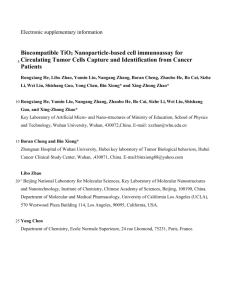Supplementary materials
advertisement

Supplementary materials Plasmonic gold nanoparticles modified titania nanotubes for antibacterial application Jinhua Li, Huaijuan Zhou, Shi Qian, Ziwei Liu, Jingwei Feng, Ping Jin, and Xuanyong Liu State Key Laboratory of High Performance Ceramics and Superfine Microstructure, Shanghai Institute of Ceramics, Chinese Academy of Sciences, Shanghai 200050, China. Corresponding Authors. E-mail: xyliu@mail.sic.ac.cn or p-jin@mail.sic.ac.cn. Experimental Section Samples fabrication and modification: Commercial pure Ti plates (purity > 99.85%, Grade 1, Baoji Shi Shenghua Non-ferrous Metal Materials Co., Ltd, China) with dimensions of 10 mm × 10 mm × 1 mm were ultrasonically cleaned in ethanol and deionized water several times, followed by pickling in a 5 wt% oxalic acid solution at 100 ºC for 2 h to remove the oxide layer and obtain a homogeneous surface. Then the samples were ultrasonically cleaned in deionized water and dried in ambient atmosphere for further use. The TiO2 nanotube arrays on Ti surface were prepared by electrochemical anodization in the ethylene glycol electrolyte (containing 0.25 wt% NH4F and 1 vol% H2O). A two electrode configuration was utilized for anodization, with a graphite plate serving as the cathode. A two-step anodization process was conducted on a WYJ-5A150V DC power supply at 50 V for 2 h at room temperature (illustrated in Scheme S1(a)). Afterwards, the TiO2 nanotube arrays were gently rinsed in diluted HF solution to clean the sample surface. Finally, the anodized samples were calcined at 450 ºC for 2 h to crystallize. The Au nanoparticles-coated TiO2 nanotube arrays were prepared by a magnetron sputtering method. The schematic diagram of the magnetron system (ULVAC Corp., Model ACS-4000-CS) is depicted in Scheme S1(b). TiO2 nanotube arrays served as the substrates. Au nanoparticles were subsequently fabricated by sputtering Au target (99.99%) at room temperature. Before sputtering, the TiO2 nanotube substrates were thoroughly cleaned in ethanol and then dried with pure nitrogen flow. For the deposition of Au nanoparticles, dc power of 15 W was employed and the deposition pressure was kept at 0.4 Pa. The deposition speed of Au was estimated at 2 nm per min. Finally, some of the Au-coated TiO2 nanotube samples were annealed at 400 ºC for 20 min under vacuum atmosphere to enlarge the size of Au nanoparticles. The obtained samples were denoted as Au@TiO2 and Annealed-Au@TiO2, respectively. Surface characterization: The surface topographies were characterized by field-emission scanning electron microscopy (FESEM; Magellan 400, FEI, USA), equipped with an energy dispersive X-ray spectroscopy (EDS). The crystallinity of the films was studied using an X-ray diffractometer (XRD; D/Max, Rigaku, Tokyo, Japan) fitted with a Cu Kα (λ = 1.541 Å) source at 40 kV and 100 mA, in the range of 2θ = 10º~100º with a step size of 0.02º. Phase identification was carried out with the help of the standard JCPDS database. In the X-ray diffraction experiment, the glancing angle of the incident beam against the surface of the specimen was fixed at 1º. Photoluminescence (PL) analysis was conducted using a FluoroMax ®-4 fluorescence spectrometer (Horiba Scientific, New Jersey, USA) equipped with a broadband pulsed UV xenon lamp source. The absorption spectra of the TiO2 nanotubes and the Au@TiO2 systems were recorded on a Perkin Elmer Lambda 750 UV/Vis/NIR with an integrating sphere detector. Meanwhile, TEM analysis was conducted with field-emission transmission electron microscope (TEM; JEM-2100F, JEOL Ltd, Tokyo, Japan), with an accelerating voltage of 200 kV. Samples for the investigation were scratched off from the substrate and dispersed in ethanol using ultrasound. A droplet of the suspension was placed on a holey copper grid covered with porous carbon film. Antibacterial efficiency evaluation: The antibacterial ability of the samples in darkness was evaluated by bacteria counting method using Gram-positive Staphylococcus aureus (S. aureus, ATCC 25923) and Gram-negative Escherichia coli (E. coli, ATCC 25922). The samples were sterilized in a series of ethanol solutions (75 and 100 v/v%) at room temperature for 2 h. A solution containing the bacteria at a concentration of 106 CFU/mL was introduced onto the sample to a density of 60 μL/cm2. The samples with the bacteria solution were incubated at 37 ºC for 24 h. The dissociated bacteria solution was collected and inoculated into a standard agar culture medium. After incubation at 37 ºC for 24 h, the active bacteria were counted in accordance with the National Standard of China GB/T 4789.2 protocol and the antimicrobial ratio was calculated using the following formula, R ( A B) 100% A where R is the antimicrobial ratio, A is the average number of bacteria on the control sample (CFU/sample); B is the average number of bacteria on the testing samples (CFU/sample). In the SEM examination, a solution containing the bacteria at a concentration of 106 CFU/mL was put on the sample to a density of 60 μL/cm2, incubated at 37 ºC for 24 h, fixed, and dehydrated in a series of ethanol solutions (30, 50, 75, 90, 95, and 100 v/v%) for 10 min each sequentially, with the final dehydration conducted in absolute ethanol (twice) followed by drying in the hexamethyldisilizane (HMDS) ethanol solution series. Supplementary data Table S1. Data for the energy level positions of Au and TiO2. Materials EF (eV) Au -5.1a TiO2 -4.13b a From reference [1]. b From reference [2]. c Calculated values. d From reference [3]. Eg (eV) EC (eV) EV (eV) 3.12c -4.14d -7.26c Scheme S1. Schematic fabrication procedures of the TiO2 nanotube arrays and the Au nanoparticles-coated TiO2 nanotube arrays on Ti surface through a combined method of electrochemical anodization (a) and magnetron sputtering (b). In (b): 1, rotating controller; 2, ionization vacuum gauge; 3, resistance vacuum gauge; 4, small angle valves; 5, magnetron sources; 6, robot; 7, reflector; 8, heater; 9, substrate. Figure S1. XRD patterns of the as-prepared samples, showing the diffraction peaks of anatase TiO2 and Au phases (a), and EDS spectra obtained from the surfaces of Au@TiO2 (b) and Annealed-Au@TiO2 (c), showing the Au loading content. Figure S2. Photoluminescence (PL) spectra obtained from the surfaces of TiO2, Au@TiO2 and Annealed-Au@TiO2 with an excitation wavelength at 300 nm. Figure S2 shows the PL spectra of the TiO2 and Au@TiO2 systems excited by a broadband pulsed UV xenon lamp source, which consists of an excitonic emission at 397 nm with energy of light approximately equal to bandgap of anatase (387.5 nm), and a main defect emission at 468 nm due to surface oxygen vacancies and defects.4 After TiO2 nanotubes were incorporated with Au nanoparticles, the band gap emission was strongly enhanced. As shown in Figure 2(a), a strong plasmonic absorption of Au nanoparticles around 580 nm emerged on Au@TiO2, although the absorption presents quite broad due to inhomogeneity.5 For Annealed-Au@TiO2, it exhibited a stronger plasmonic absorption at around 600 nm with a red shift.6 The nonradiative plasmon decay occurs via excitation of electron-hole pairs, which can produce hot electrons at higher energy states.7 The hot electrons in Au nanoparticles can transfer to the conduction band of TiO2 nanotubes. After that, the electrons relax extremely fast and rapidly recombine with holes in the valence band.8-9 As a result, the excitonic emission of TiO2 nanotubes may be greatly enhanced by the LSPR of Au nanoparticles.10-11 Meanwhile, since the loading level of Au nanoparticles is very high and can thoroughly cover TiO2 nanotubes both on the top and along the inwall, the influence of scattering is not negligible here.3 The photons are scattered by Au nanoparticles, acting as a mirror, which can increase the path length of photons and the number of electron-hole pairs in Au@TiO2 systems, and further enhance the light absorption.12 Through the photons scattering, the PL intensity may be improved. Furthermore, plasmonic nanoparticles with a larger size are more efficient in scattering photons,12-13 which may account for the different PL results for Annealed-Au@TiO2 and Au@TiO2. Besides, the Au nanoparticles in Au@TiO2 systems may act as the recombination center of the photo-generated electrons and holes, contributing to the increase of the emission intensity.4 References 1 H. B. Michaelson, Journal of Applied Physics 48, 4729 (1977). 2 A. Imanishi, E. Tsuji, and Y. Nakato, The Journal of Physical Chemistry C 111, 2128 (2007). 3 Z. Xuming, C. Yu Lim, L. Ru-Shi, and T. Din Ping, Reports on Progress in Physics 76, 046401 (2013). 4 J. Yu, L. Yue, S. Liu, B. Huang, and X. Zhang, Journal of Colloid and Interface Science 334, 58 (2009). 5 W. Hou, Z. Liu, P. Pavaskar, W. H. Hung, and S. B. Cronin, Journal of Catalysis 277, 149 (2011). 6 G. K. Joshi, P. J. McClory, S. Dolai, and R. Sardar, Journal of Materials Chemistry 22, 923 (2012). 7 C. Sönnichsen, T. Franzl, T. Wilk, G. von Plessen, J. Feldmann, O. Wilson, and P. Mulvaney, Physical Review Letters 88, 077402 (2002). 8 K. T. Tsen, Ultrafast physical process in semiconductors. (Academic Press, New York, 2001). 9 V. I. Klimov and D. W. McBranch, Physical Review Letters 80, 4028 (1998). 10 G. An, S. Jin, C. Yang, Y. Zhou, and X. Zhao, Optical Materials 35, 45 (2012). 11 A. L. Stepanov, Rev. Adv. Mater. Sci. 30, 150 (2012). 12 S. Linic, P. Christopher, and D. B. Ingram, Nat Mater 10, 911 (2011). 13 D. D. Evanoff and G. Chumanov, ChemPhysChem 6, 1221 (2005).






